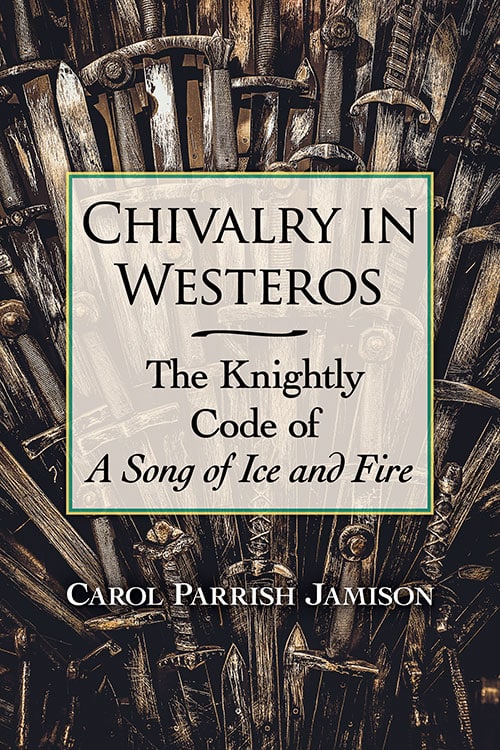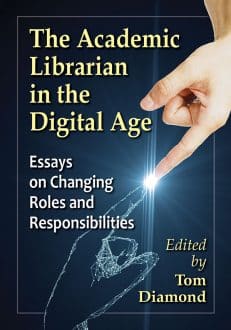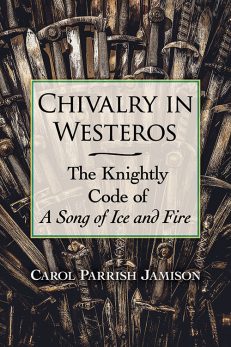Review Fix chats with Chivilary in Westeros author Carol Parrish Jamison to find out what makes the Game of Thrones saga a special one and what motivated her to write about it.
Review Fix: What inspired the creation of this book?
Carol Parrish Jamison: My interest in GoT began when, some years back, I picked up Martin’s first novel in his A Song of Ice and Fire series as a relaxing summer read. I was hooked. As a professor of medieval literature, I’m interested in many aspects of the Middle Ages, especially chivalry. I’ve also developed an interest in medievalism, the representation of the Middle Ages in post-medieval works. Thus, I was drawn to Martin’s novels and their emphasis on chivalry. Soon after, I discovered the GoT HBO series. As a film representation, it doesn’t exactly duplicate the novels, but still portrays many of the themes that interest me. I was also inspired by my experiences in the classroom. I have found that works of medievalism can be a gateway to garnering interest in the Middle Ages.
Review Fix: What makes Game of Thrones worthy of a book like this in your opinion?
Jamison: George R. R. Martin is an excellent storyteller. Even more so than the HBO series, his novels weave a complex narrative with relatable characters, all the while taking us into a faux medieval world that feels authentic. It’s not an exact duplication of the Middle Ages, and you can’t pinpoint a single historical moment in the Middle Ages that Martin is duplicating. Nonetheless, one can detect the transmission of important themes, particularly chivalry, which are fleshed out in interesting ways for modern audiences.
Review Fix: What was the writing process like?
Jamison: I went about my usual scholarly process for medieval research, but the scope of this project also led me to work closely with social media, reviews, and websites devoted to Game of Thrones. My editions of Martin’s novels are threadbare at this point from reading and re-reading. In the tradition of medieval scribes, my copies of Martin’s novels are, like my copies of Chaucer and Malory and other medieval texts, filled with marginal notes. I was fortunate to have an excellent student worker, Julia Broyles, who helped me tremendously with indexing and organizing. In all, it was a fun process.
Review Fix: In your opinion, does Game of Thrones have the same staying power as Lord of the Rings?
Jamison: Only time will tell, but I believe Game of Thrones certainly has the potential to match Lord of the Rings. Like Tolkien, Martin creates an elaborate, detailed world that has attracted an amazing number of followers. Game of Thrones has become a cultural phenomenon in ways that equal, perhaps may even surpass, Tolkien’s prominence. However, Martin will need to complete the novels first.
Review Fix: Why do you think people are so entranced by GoT right now?
Jamison: Everyone can find something relatable in Martin’s Westeros. I’ve taught two GoT-themed classes so far, and I use GoT as a reference point in my class on Arthurian chivalry. I find that the novels offer a gateway to students with varied interests, even those who aren’t particularly attracted to the Middle Ages. GoT may be set in a faux-medieval world, but many aspects of it mirror modern society and, as evidenced by its popularity, resonate with modern audiences. In my GOT-themed courses, one student interested in race studies wrote about Martin’s portrayal of Dothraki and the Summer Islanders; a student going into education wrote about Martin’s portrayal of children; a student interested in religion wrote about the religions of Westeros. In sum, despite the medieval setting, GoT intersects with modern culture.
Additionally, I saw an article recently that makes the point that GoT is the last show everyone will watch together. It’s a shared phenomenon. I’m in Savannah, and my daughter is in Colorado, but we tune in at the same time on Sunday night and trade texts during each episode. It’s a fun way to connect despite the physical distance between us. I look forward to Monday mornings when my students and friends share their thoughts and predictions with me. I received four separate emails from colleagues after Episode Four, asking me if I had spotted the Starbucks cup that was inadvertently left on the table in front of Danaerys. I will miss these experiences after the show’s finale.
Review Fix: How do you craft a book like this from a scholarly perspective and still be entertaining to a casual reader?
Jamison: This was my biggest challenge. I wanted the book to appeal to both scholars and casual readers, and I hope I succeeded. I tried to be as descriptive as I could when defining medievalism and chivalry and other key terms. I also focus more on the novels than the HBO series, but I tried not to alienate die-hard fans of the series who haven’t read the novels. Ideally, I may have inspired some HBO fans to pick up the novels! As good as the HBO series is, the novels are, in my opinion, even better.
Review Fix: What did you learn about GoT through the writing process that you weren’t expecting?
Jamison: The incredible web of back stories in GoT is something I didn’t fully appreciate when I began this book. Whereas Tolkien’s Silmarillion also contains an expansive back story, Martin packs much of the back story right into the pages of his novels. They are filled with songs, histories, and legends, and only a fraction of these make their way into the HBO series. Westeros also has an expansive literary tradition that in some ways mirrors the evolution of literacy in the Middle Ages. I was fascinated with how Martin developed these aspects of his novels.
Review Fix: What are your goals for the book?
Jamison: I hope both fans and scholars will like it. I also hope it will open some doors for an increasing appreciation of medievalism as a legitimate field of study in itself. And perhaps I can inspire some general readers to sit down and read Malory!
Review Fix: How would you like it to be remembered?
Jamison: Ideally, I’d like this book to be remembered as a worthy contribution to the burgeoning field of medievalism and to studies of chivalry.
Review Fix: What’s next?
Jamison: I’ve stepped away from medievalism for a bit and returned to a few projects that are strictly in the realm of medieval studies. I’m working on a couple of projects on secular saint’s lives right now, primarily Chaucer’s “Man of Law’s Tale,” “Clerk’s Tale,” and their analogues. It’s interesting that even these works intersect with Martin. For instance, when I recently taught the “Man of Law’s Tale,” which contains a wedding slaughter scene, one of my students pointed out that this reminded her of the Red Wedding. Traditionally, this Chaucerian tale hasn’t been a favorite of my students, but they were quite enthusiastic about it. Maybe Martin gives them a path to appreciating it. Again, this experience illustrates how GoT (and other works of medievalism, such as Last Kingdom and the Harry Potter series) can be an intersection for students of medieval literature. I’m sure I’ll keep coming back to GoT. It’s rich with possibilities for scholars of medievalism and medieval studies, and of course for students and fans, as well.
Review Fix: Anything else you’d like to add?
Jamison: No, but I’d like to thank you for not asking me who will ultimately sit on the Iron Throne. I have my preference, but GoT is full of surprises, so I wouldn’t be willing to bet.






